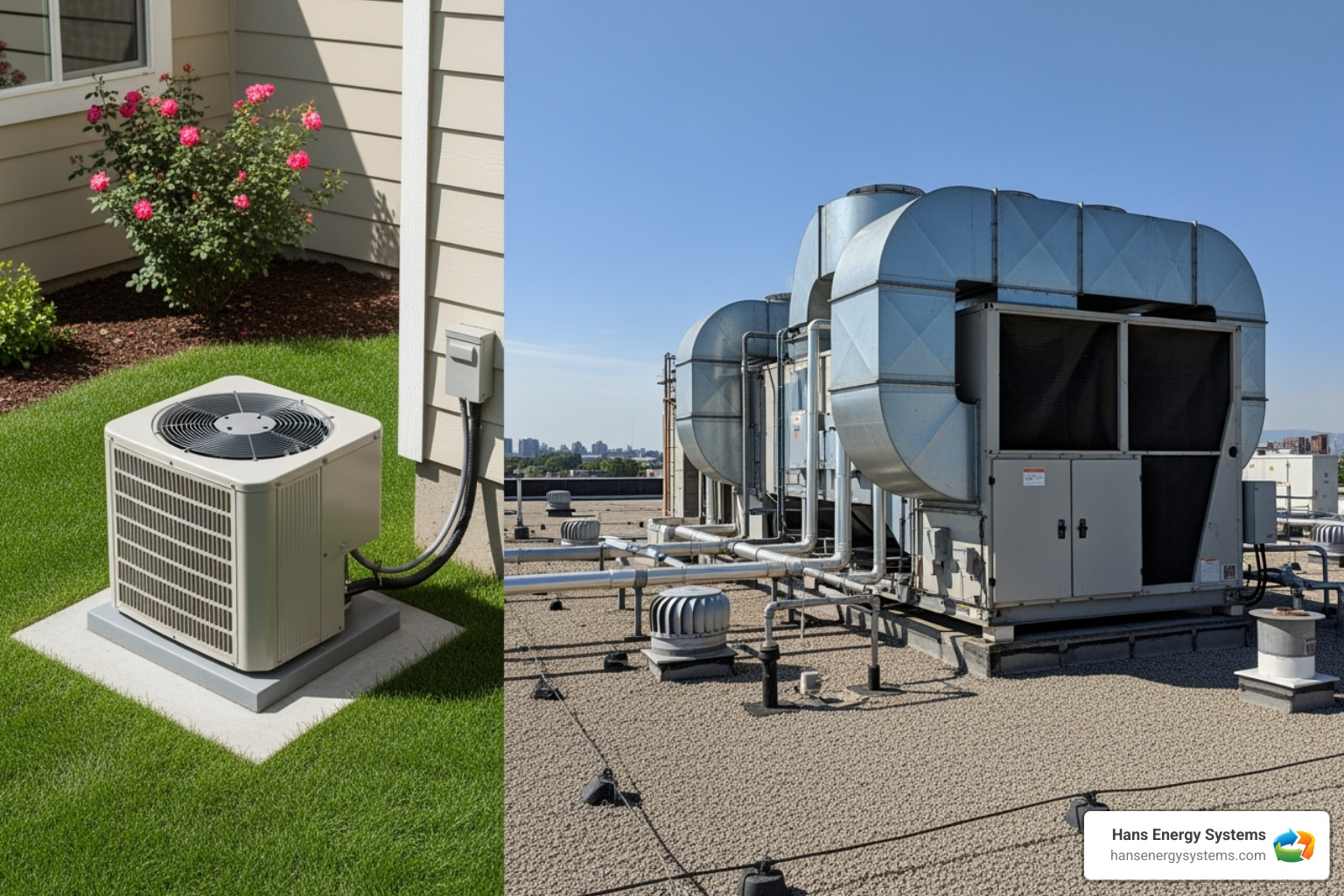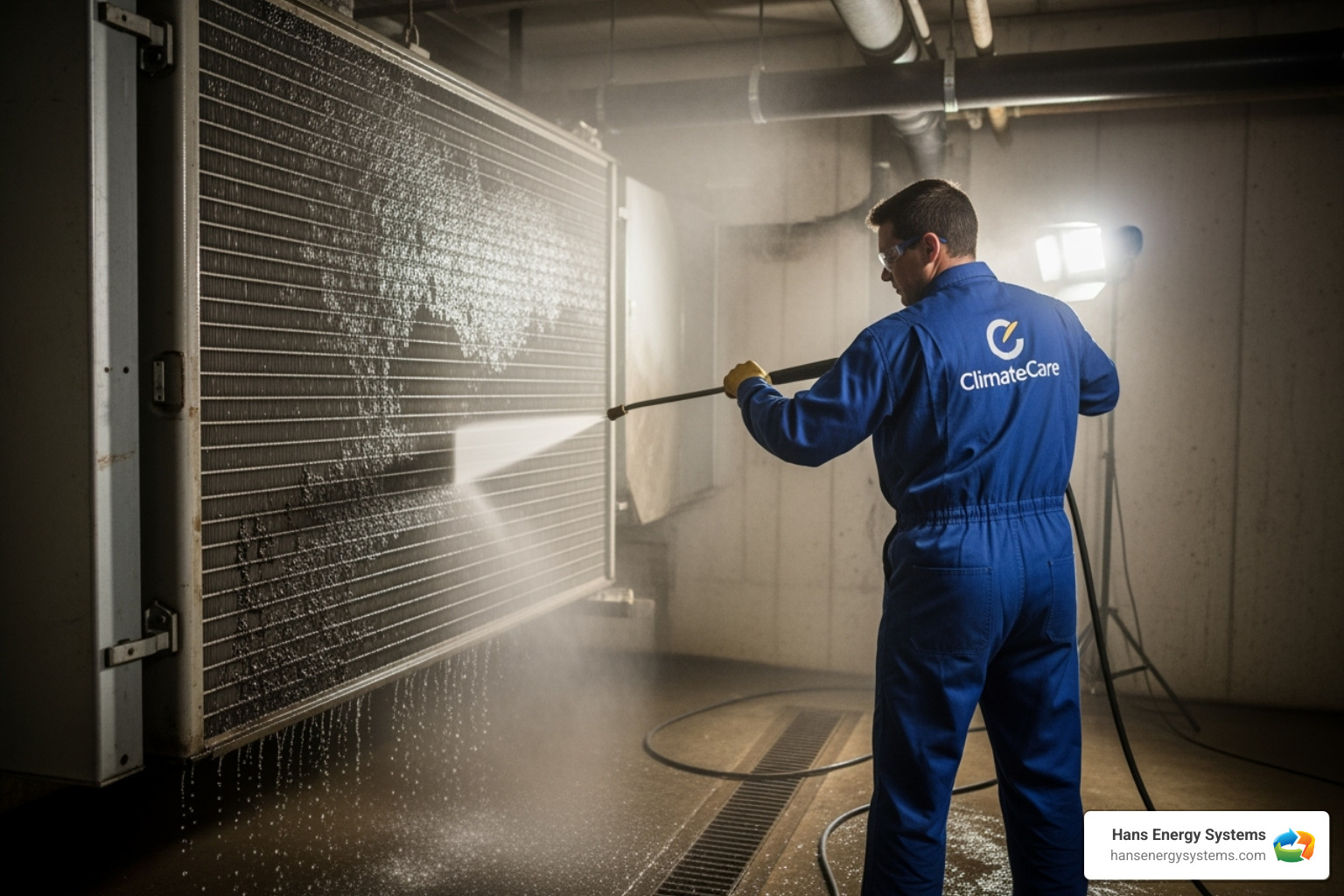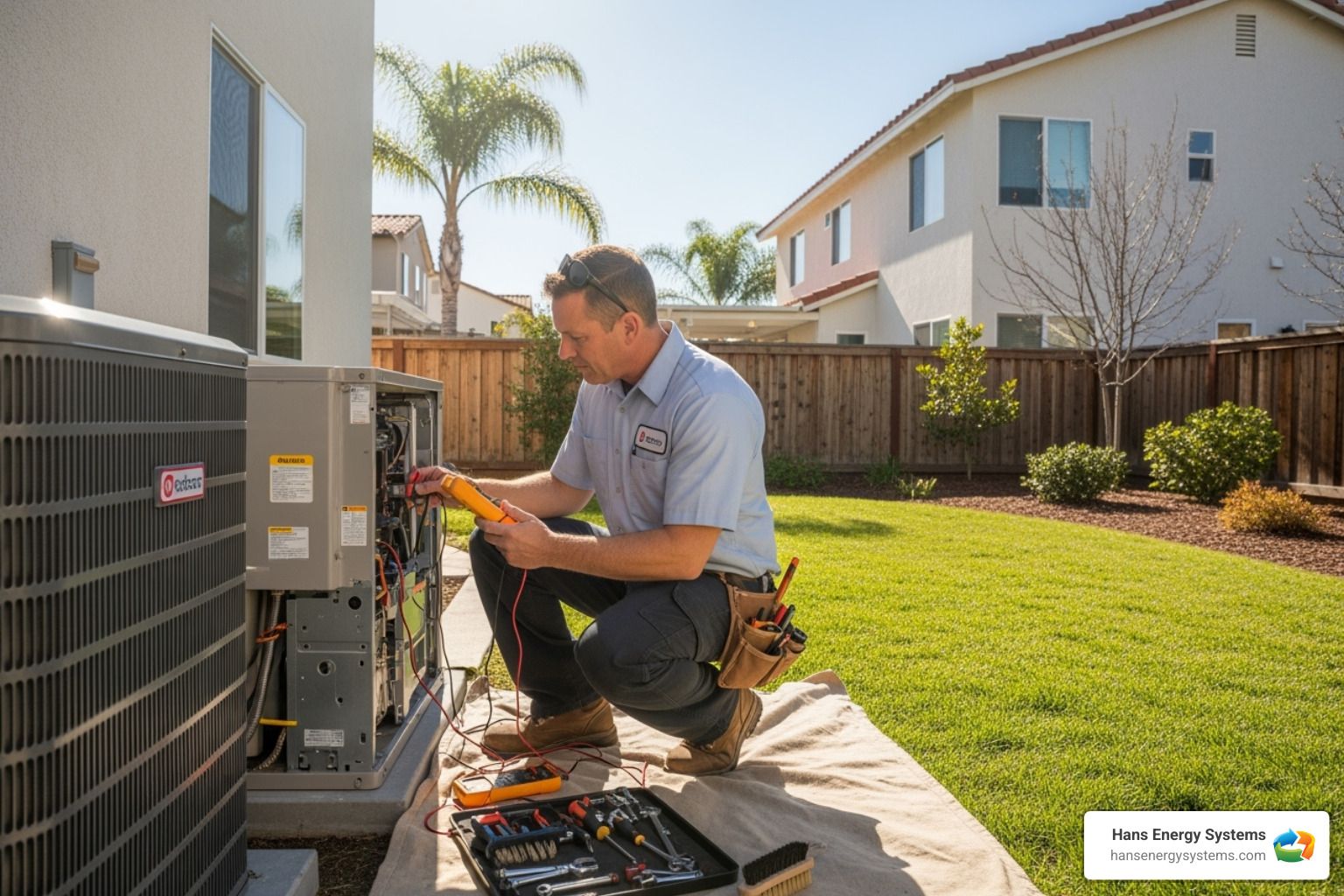Why Commercial HVAC Systems Are Critical for Business Success
HVAC system commercial solutions are engineered to provide optimal indoor conditions in commercial buildings, where the complexity far surpasses residential counterparts. These systems manage temperature, humidity, and air quality across large spaces for multiple occupants with diverse needs.
Quick Answer: What is a Commercial HVAC System?
Commercial HVAC systems have three core functions:
- Heating – Warms air using furnaces, boilers, or heat pumps
- Ventilation – Exchanges stale indoor air with fresh outdoor air, filters pollutants
- Air Conditioning – Cools air by removing heat through refrigeration cycles
Key differences from residential systems:
- Much larger capacity (up to hundreds of tons vs. residential max of 5 tons)
- Modular design with components located together for easier maintenance
- Advanced zoning capabilities for different areas
- Include economizers for “free cooling” using outside air
- More complex drainage and ventilation requirements
A sweltering office or poor air quality directly reflects the performance of the commercial HVAC system. Commercial buildings need robust systems to cool much larger spaces than homes. For example, a 500-ton chiller can handle loads equivalent to dozens of residential units. These systems also maintain healthy CO2 levels (under 1000 ppm) through effective ventilation, which directly impacts occupant productivity and health.
The stakes are high. Poor indoor air quality is especially bad for retail businesses that depend on positive in-store experiences. Meanwhile, a properly functioning HVAC system can reduce energy costs by 5-40% through preventative maintenance alone.

Core Functions and Key Differences from Residential Systems
A commercial HVAC system commercial solution does far more heavy lifting than the unit cooling your home, operating on a completely different scale.

Unlike scattered residential components, commercial equipment uses a modular design, grouping components together for easier installation and maintenance, often on a rooftop. This rooftop placement also frees up valuable indoor space. These powerful systems require robust electrical setups and complex drainage systems to handle the massive amounts of condensation they produce. For a complete look at what we offer, check out our HVAC services.
Why Ventilation is Critical in Commercial Spaces
Ventilation is about keeping people healthy and productive. With many people sharing a space, CO2 levels can climb quickly. Proper ventilation keeps CO2 levels under 1000 molecules per million, preventing the cognitive impairment that occurs at higher concentrations.
Poor indoor air quality leads to drowsy employees, more sick days, and customers who won’t linger in retail settings. Effective ventilation removes odors, pollutants, and excess humidity while bringing in fresh air. Different businesses also have specialized needs:
- Restaurants need powerful exhaust systems for cooking fumes.
- Fitness centers require extra ventilation to manage humidity and odors.
- Laboratories need precise air filtration to maintain sterile conditions.
Commercial vs. Residential: More Than Just Size
The differences go far beyond capacity, which can range from 10 to hundreds of tons for commercial units compared to a 5-ton max for homes.
- Zoning Capabilities: Commercial systems offer sophisticated zoning for precise, individual temperature control across different areas, such as a sunny office versus a windowless conference room. Some systems can connect up to 64 indoor units to a single outdoor unit.
- Maintenance Complexity: These systems work harder and have more components, requiring specialized expertise and professional tools for diagnosis and repair.
- Economizers: A key commercial feature, economizers provide “free cooling” by using cool outside air instead of running the compressor. This is a huge energy saver, but studies show nearly two-thirds of units have malfunctioning economizers, highlighting the need for professional maintenance.
- Durability and Lifespan: Commercial systems are built for continuous, heavy use and often outlast residential units despite working much harder.
Understanding these differences shows why commercial HVAC is an entirely different category of climate control technology. For more local insights and resources, visit our HVAC Resources Poway CA page.
A Guide to Commercial HVAC System Types
Choosing the right HVAC system commercial solution is a critical decision that impacts energy costs, comfort, and efficiency. The ideal system depends on your building’s specific needs. Here are the main types:
| System Type | Ideal Application | Key Advantage | Primary Limitation |
|---|---|---|---|
| Single-Split Systems | Small offices, retail shops, single-zone spaces | Affordability, simple installation, dedicated control for one area | Limited to single-zone heating/cooling, not scalable for larger needs |
| Multi-Split Systems | Medium-sized offices, restaurants, boutique hotels | Multiple indoor units on one outdoor unit, personalized zone control | Less efficient than VRF for large, diverse needs; limited number of zones |
| Variable Refrigerant Flow (VRF) Systems | Large, multi-zone buildings (hotels, offices, hospitals) | Exceptional energy efficiency, simultaneous heating/cooling, precise control | Higher upfront cost, complex installation, requires specialized technicians |
| Rooftop Units (RTUs) / Packaged Systems | Low-rise commercial buildings, warehouses, retail stores | All-in-one design, saves indoor space, easy maintenance access | Less energy-efficient than advanced systems, not ideal for complex layouts |
Single-Split and Multi-Split Systems
These systems are excellent for smaller commercial buildings or specific zones within a larger facility.
- Single-Split Systems: One outdoor unit connects to one indoor unit, making them perfect for a single room like a small office or retail shop. They offer straightforward installation and dedicated temperature control.
- Multi-Split Systems: These allow multiple indoor units (up to 5) to connect to a single outdoor unit, providing personalized comfort across different zones in medium-sized spaces like offices or restaurants.

Variable Refrigerant Flow (VRF) Systems
VRF systems are advanced, highly energy-efficient solutions for large, multi-zone buildings. They can be up to 30 percent to 40% more efficient than traditional systems due to variable-speed compressors that adjust output to real-time needs. A key advantage is the ability to provide simultaneous heating and cooling in different zones through heat recovery. This is ideal for hotels, mixed-use buildings, or offices with varying sun exposure. They also offer quiet operation (as low as 19 dB), making them a smart, long-term investment. To learn more, check out this VRF systems explanation.
Rooftop Units (RTUs) or Packaged Systems
Rooftop Units (RTUs), or packaged systems, are common for low-rise commercial buildings. Their all-in-one design contains all components in a single unit, simplifying installation, saving indoor space, and allowing easy service access. RTUs are ideal for single-story buildings like retail stores and warehouses. Modern units can achieve up to 16 SEER ratings and have a typical lifespan of 15 to 20 years. While convenient, they are generally less efficient than systems like VRF for complex buildings, but they often provide a better return on investment for spaces under 25,000 sq ft.
Chiller Systems
Chillers are the workhorses for centralized cooling in very large facilities like data centers, industrial plants, and high-rise buildings.
- Water-cooled chillers: These are highly efficient (0.5-0.6 kW/ton) and used in large buildings but require extensive infrastructure like cooling towers.
- Air-cooled chillers: While less efficient (1.0-1.2 kW/ton), they are simpler and suitable for buildings with modest cooling loads due to lower upfront complexity.
Chillers offer a strong long-term return on investment for very large applications and are often a safer option for industrial environments. Our comprehensive Services can help you determine if a chiller is right for your needs.
Selecting the Right HVAC System Commercial Solution
Choosing the right HVAC system commercial solution is a long-term decision affecting your energy bills, comfort, and efficiency. Several factors must be considered to find the right fit.
- Building Size and Layout: A sprawling warehouse has different needs than a multi-story office building.
- Occupancy Patterns: A restaurant with dinner rushes requires a different capacity than an office with steady occupancy.
- Local Climate: In San Diego County, our temperate climate allows systems like air source heat pumps to work efficiently year-round.
- Energy Goals: Your goals, whether LEED certification, decarbonization, or lower utility bills, will point toward different system types.
- Budget: Look beyond upfront costs to the total cost of ownership. A more efficient system may have a higher initial price but save more on energy over its lifetime. For guidance, see the Department of Energy’s resource on how to Save Energy in Commercial Buildings.
Understanding Your HVAC System Commercial Needs
Specific operational details are critical for system performance.
- Load Calculation: This professional assessment analyzes your building’s size, insulation, windows, occupancy, and heat sources to determine the precise heating and cooling capacity needed. An incorrect load calculation leads to an inefficient system that is either overworked or oversized.
- Business Operations: Unique demands require specialized solutions. Server rooms need 24/7 cooling, kitchens need powerful ventilation, and fitness centers need to manage high humidity. For specialized needs, our Industrial HVAC services can design custom solutions.
- Future Expansion: If you plan to grow, choose a scalable system now to avoid future complications.
- Zoning Requirements: Different areas have different needs (e.g., sunny offices vs. shaded conference rooms). Proper zoning improves comfort and energy efficiency by conditioning only the spaces that need it.
The Role of Economizers in Energy Efficiency
Economizers are a key commercial HVAC feature that provides “free cooling.” When outside air is cool enough, the economizer brings it inside to cool the building instead of running the energy-intensive compressor. This reduces energy consumption, lowers operational costs, and lessens wear and tear on equipment.
This feature is especially effective in temperate climates like San Diego’s. However, studies show that nearly two-thirds of rooftop units have malfunctioning economizers, meaning businesses are missing significant savings. Regular maintenance is crucial to ensure this energy-saving feature is working correctly.
Proactive Care: Common Issues & Essential Maintenance
Regular HVAC system commercial maintenance is the best defense against expensive, disruptive emergency service calls. Proactive care ensures your equipment lasts longer, runs more efficiently, and keeps everyone comfortable, preventing surprise breakdowns that can shut down operations.

Our HVAC Service in Poway CA team helps businesses stay ahead of problems before they start.
Common Problems and How to Address Them
Knowing what to watch for can save you from major headaches:
- Short Cycling: A system that constantly turns on and off wastes energy and stresses components. This often indicates refrigerant leaks, dirty coils, or an oversized system.
- Refrigerant Leaks: A hissing sound is a common sign. Low refrigerant makes the system cool improperly and overworks the compressor, which can lead to failure.
- Dirty Coils: Just 0.042 inches of dirt on coils can reduce efficiency by 21%. Regular cleaning of indoor and outdoor coils is essential for effective heat transfer.
- Clogged Drains: This can cause significant water damage and encourage mold growth as condensate backs up into your building.
- Unusual Noises: Squeaking (belts), rattling (loose parts), hissing (leaks), or grinding (bearings) are all cries for help. Call a professional if you hear new sounds.
- Malfunctioning Belts: A loose or worn belt reduces airflow, which can cause coils to freeze and diminish comfort.
The Role of an HVAC System Commercial Maintenance Plan
Preventative maintenance can lower your energy costs by 5 to 40 percent. A proper plan transforms unpredictable emergency costs into manageable, routine care.
A good plan includes quarterly professional service visits for critical tasks. Key maintenance includes:
- Filter Changes: Typically monthly in high-traffic areas to ensure good air quality and airflow.
- Coil Cleaning: Maintains optimal heat exchange and efficiency.
- Drain Line Flushing: Prevents clogs and water damage.
- Electrical Checks: Catches potential safety hazards.
- Belt Inspections: Ensures proper tension and prevents unexpected snaps.
Our comprehensive HVAC Maintenance Plan Poway CA takes the guesswork out of system care, providing reliable performance year-round.
The Future is Efficient: Emerging HVAC Technologies
The world of HVAC system commercial technology is rapidly changing, delivering measurable improvements in efficiency, productivity, and sustainability. These innovations are helping businesses reduce energy consumption, improve comfort, and meet decarbonization goals. At Hans Energy Systems, we bring these cutting-edge solutions to our clients through Our Main Services.
Smart Controls and Building Automation
Modern smart controls and building automation systems constantly optimize HVAC performance. Key features include:
- Predictive Maintenance: AI-powered systems analyze operational data to spot potential problems before they cause breakdowns, giving you advance warning to schedule service.
- Automatic Adjustments: Systems consider occupancy, weather, and even energy prices to optimize performance, learning when and where to adjust heating and cooling.
- IoT Integration: Connecting HVAC with other building systems (like security and lighting) allows for seamless coordination. For example, the system can enter an energy-saving mode when the building is empty.
- Centralized Control: Facility managers can monitor and adjust entire systems from a single dashboard, providing complete visibility and control over one or multiple locations.
Innovations in Hardware
Hardware is also undergoing a revolution, with several key advancements:
- Magnetic Bearing Chillers: These highly efficient machines (0.3 kW/ton) use magnetic levitation to eliminate friction, resulting in 50% less maintenance and a 25-year lifespan.
- Dual-Fuel Systems: Ideal for San Diego’s climate, these hybrid systems switch between an electric heat pump and a gas furnace, choosing the most cost-effective fuel source at any given time. This can reduce operating costs by 18-22% in temperate climates.
- Geothermal Heat Pumps: By tapping into the earth’s stable temperature, these systems can achieve up to 500% efficiency, producing five units of energy for every one unit of electricity consumed. They require careful site evaluation but are often eligible for efficiency incentives.
- Advanced Refrigerants: The industry is shifting to refrigerants with lower global warming potential, helping businesses meet environmental regulations without sacrificing performance.
Conclusion
Choosing the right HVAC system commercial solution is a critical decision for your business’s comfort, efficiency, and profitability. The journey starts with understanding your unique needs, from building size and layout to daily operations.
System selection is just the beginning; real value comes from proper maintenance and embracing new technology. Regular upkeep can slash energy costs by 5-40%, while emerging technologies like smart controls and advanced hardware offer unprecedented efficiency and longevity.
At Hans Energy Systems, we understand that your commercial HVAC needs are as unique as your business. Our team knows the San Diego County climate and is dedicated to delivering solutions that fit your specific situation, whether you’re upgrading an old system or planning a new installation.
Your HVAC system should support your business goals, not create headaches. When you’re ready to find the perfect climate solution for your commercial space, we’re here to help. For comprehensive support custom to your business needs, check out All of Hans Energy Systems’ Services.
For expert guidance on selecting, installing, and maintaining the perfect climate solution for your business in San Diego County, explore our Commercial HVAC Services in Poway, CA.





